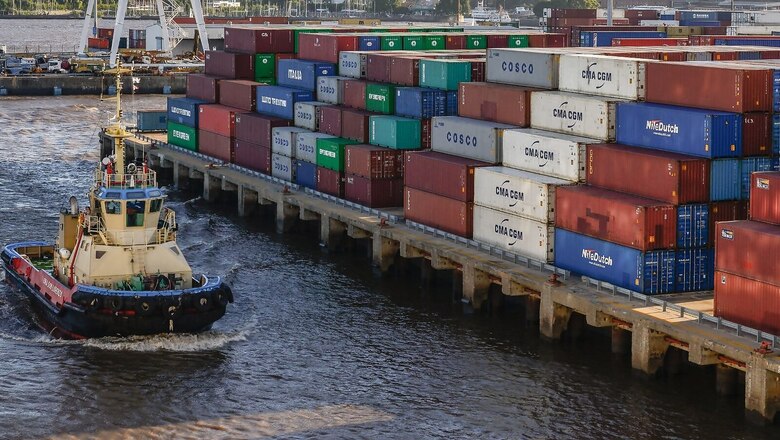
views
India’s exports recorded a flat growth of 0.59 per cent to USD 31.99 billion in November, even as trade deficit widened to USD 23.89 billion during the month, according to the data released by the government on Thursday. Exports stood at USD 31.8 billion in November last year.
Imports rose by 5.37 per cent to USD 55.88 billion in November as compared to USD 53.03 billion in the corresponding month a year ago, the data showed.
During April-November 2022, exports rose by 11 per cent to USD 295.26 billion as against USD 265.77 billion in the same month last year.
Imports, however, rose by 29.5 per cent to USD 493.61 billion during the eight months period of this fiscal. It was USD 381.17 billion during April-November 2021, as per the data. The merchandise trade deficit for April-November 2022 has increased to USD 198.35 billion as against USD 115.39 billion in April-November 2021.
India’s exports entered negative territory after a gap of about two years, declining sharply by 16.65 per cent to USD 29.78 billion in October, mainly due to global demand slowdown, even as trade deficit widened to USD 26.91 billion.
The World Trade Organisation (WTO) has projected that the global trade growth will rise by 3.5 per cent in 2022 but only one per cent in 2023.
The exports exhibited a positive growth in 15 out of 30 key sectors in November as compared to the same period last year.
Sectors which recorded positive growth include electronic goods (54.48 per cent), gems and jewellery (4.61 per cent), RMG of textiles (11.70 per cent), pharmaceuticals (8.66 per cent), rice (19.16 per cent), and leather (8.68 per cent).
“As a thriving economy with close integration into the global value chain, certain sectors do face the challenges of the slowing global demand more severely than others,” an official statement said.
It said that the 15 per cent export duty on steel weighed on engineering exports but its removal now should improve the situation.
There is a decline in exports in chemical sector in dyes and organic chemicals due to slowdown in demand in traditional textile markets such as China, Turkey, Bangladesh, it added.
Textile exports fell due to global demand slowdown as high inflation across the developed world has reduced consumers’ purchasing capacity.
“As resilient domestic demand, a re-invigorated investment cycle along with strengthened financial system and structural reforms have kept the economy on an upswing.
“Certain domestic demand supply gaps and natural requirements for a large economy like ours necessitate imports. For example, crop across India are dependent on fertilizers import and the geopolitical conflict has also roiled up market for crucial chemicals,” it said.
Moreover, pressure from persistently high global inflation despite accelerated monetary tightening has also raised the import bill for essential commodities like crude petroleum, coking coal that need to be imported, it said.
India’s trade exhibited a phenomenal performance in 2021-22 attaining unprecedent exports in merchandise and services such that exports reached an all-time high. The global economy poses tremendous challenges in the current year as it continues to navigate an increasingly turbulent and uncertain environment.
However, India’s trade is moving forward on the high growth wave even with the high base of last year, and despite global demand slowdown, exports performance continues on the high growth run, the commerce ministry said.
Federation of Indian Export Organisations (FIEO) DG Ajay Sahai said that exports moving to positive territory, after a drop in October is on expected line though the challenges continue.
“The off take has slowed down with rising inflation in most economies affecting the purchasing power. Moreover, the large departmental stores are maintaining lean inventories as credit cost of building inventories have gone up with interest rates moving northwards. The next move by Fed would be very important and crucial,” he said.
Read all the Latest India News here


















Comments
0 comment